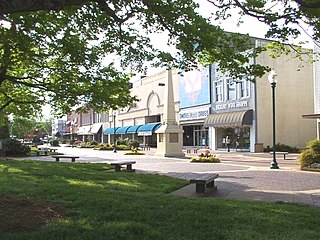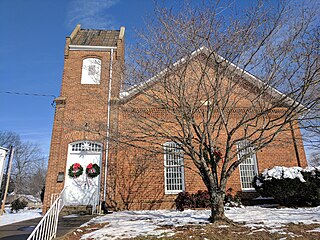Charlotte metropolitan area | ||
|---|---|---|
| Charlotte–Concord–Gastonia, NC–SC Metropolitan Statistical Area | ||
 Uptown Charlotte Skyline | ||
 Map of Charlotte–Concord, NC CSA
| ||
| Country | | |
| State | | |
| Core city | | |
| Principal cities | - Concord - Gastonia - Rock Hill - Huntersville - Kannapolis - Mooresville - Hickory - Indian Trail - Monroe - Salisbury | |
| Area | ||
| • Metropolitan Statistical Area | 3,198 sq mi (8,280 km2) | |
| • Land | 3,149 sq mi (8,160 km2) | |
| • Water | 49 sq mi (130 km2) | |
| Elevation | 305–2,560 ft (93–780 m) | |
| Population (2023) | ||
| • Metro | 2,805,115 (22nd) | |
| • Metro density | 824.1/sq mi (318.2/km2) | |
| • CSA | 3,387,115 (19th) | |
| GDP | ||
| • MSA | $228.9 billion (2022) | |
| Time zone | UTC-5 (EST) | |
| • Summer (DST) | UTC-4 (EDT) | |
| Zip Codes | 280xx,281xx,282xx,286xx,297xx | |
| Area code(s) | 704, 803,828,980 | |
The Charlotte metropolitan area, sometimes referred to as Metrolina, is a metropolitan area of the U.S. states of North and South Carolina, containing the city of Charlotte. The metropolitan area also includes the cities of Gastonia, Concord, Huntersville, and Rock Hill as well as the large suburban area in the counties surrounding Mecklenburg County, which is at the center of the metro area. Located in the Piedmont, it is the largest metropolitan area in the Carolinas, and the fourth largest in the Southeastern United States. The Charlotte metropolitan area is one of the fastest growing metropolitan areas in the United States. [2]
Contents
- Nicknames and regional identity
- Geography
- Counties
- Largest cities and towns
- Cities and Towns: 5,000 to 10,000 in Population
- Suburban towns and cities under 5,000 in population
- Unincorporated communities
- Transportation
- Mass transit
- Roads
- Air
- Higher education
- Four-year institutions
- Two-year institutions
- Defunct institutions
- Healthcare
- Attractions
- Nature and geography
- Cultural attractions
- Entertainment
- Shopping
- Sports
- Economy
- Notable residents
- Government
- See also
- References
- External links
There are two official metropolitan boundaries for the Charlotte metropolitan area: the Charlotte–Concord–Gastonia, NC–SC Metropolitan Statistical Area (MSA) [3] and the Charlotte–Concord, NC–SC Combined Statistical Area (CSA). [4] The two regions are identical except for the addition to the Charlotte-Concord CSA of the Hickory–Lenoir–Morganton metropolitan area (MSA) and three micropolitan areas, Marion, Shelby and Albemarle, that are not included in the Charlotte–Concord–Gastonia MSA. The population of the MSA was 2,595,027 [5] and the population of the CSA was 2,754,842 as of 2020 Census. [6] In 2023, [7] the Office of Management and Budget (OMB) issued new revised delineations for Combined Statistical Areas that included a 2022 population estimate of 3,333,992 for the new Charlotte–Concord, NC–SC CSA (that now includes the Hickory-Lenoir-Morganton Metropolitan Statistical Area and the Marion, Albemarle and Shelby Micropolitan Statistical Areas). The metropolitan area is slightly larger than 3,000 square miles (7,800 km2). The new Combined Statistical Area definition is approximately 8,536 square miles (22,108 square km) in size.
The Charlotte metro area is a major financial center, transportation hub, and entertainment destination. Charlotte is the second largest financial hub in the United States behind New York City, being the headquarters for Bank of America and Truist Financial as well as housing the East Coast headquarters and largest employment hub of Wells Fargo. Other Fortune 500 companies headquartered in the metro area include Brighthouse Financial, Duke Energy, Honeywell, Lowe's, Nucor, Sonic Automotive, Albemarle and CommScope in the Hickory area. The Charlotte metro area is the largest manufacturing region in the Carolinas. The estimated gross metropolitan product (GMP) of the metro area is over $170 billion. [8] Located in Mecklenburg County, Charlotte Douglas International Airport is the seventh-busiest airport in the world by aircraft movements and the city's location at the junction of I-85 and I-77 makes it a highway logistics center. The Charlotte metro is also one of the centers of American auto racing and is home to the Carolina Panthers, Charlotte Hornets, and Charlotte FC.
The Charlotte metro is home to a number of prominent higher education institutions, including the University of North Carolina at Charlotte, Queens University of Charlotte, Davidson College, Belmont Abbey College, Winthrop University and many more. The larger region is also home to respected institutions such as Gardner-Webb University, Lenoir–Rhyne University, Wingate University, and the Hickory campus of Appalachian State University. The primary community college for the area is Central Piedmont Community College, which has several campuses throughout Charlotte and the surrounding region.


















